Analyzing the Impact of COVID-19 on Food Market Dynamics & Prices
VerifiedAdded on 2022/12/28
|6
|1069
|63
Essay
AI Summary
This essay examines the impact of the COVID-19 pandemic on the food market, focusing on price effects and changes in supply and demand dynamics. It highlights the rise in food prices due to the pandemic, extreme climatic conditions, African swine fever, locust blights, and panic buying, which led to decreased demand and disruptions in the supply chain. The essay also discusses how consumer preferences shifted towards natural foods due to increased health consciousness. Furthermore, it explores the limitations of the perfectly competitive model in the context of the food market, particularly the challenges firms face in raising prices due to the homogeneity of products and the absence of entry barriers. The analysis references the impact on the UK food supply chain, illustrating the decrease in demand coupled with rising prices. The essay concludes that changes in price, quality, or quantity by any firm in perfect competition will not impact the market due to the model's underlying assumptions.
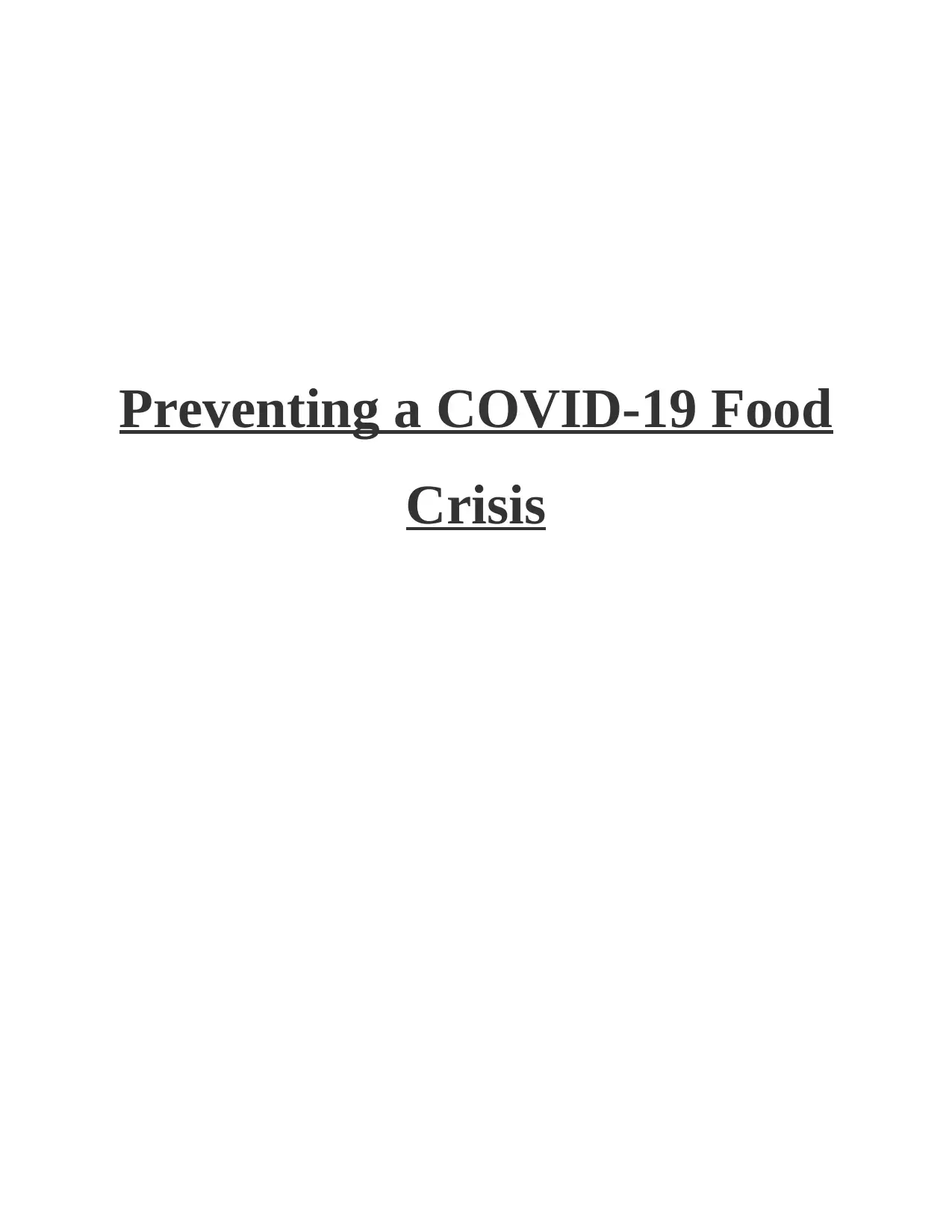
Preventing a COVID-19 Food
Crisis
Crisis
Paraphrase This Document
Need a fresh take? Get an instant paraphrase of this document with our AI Paraphraser
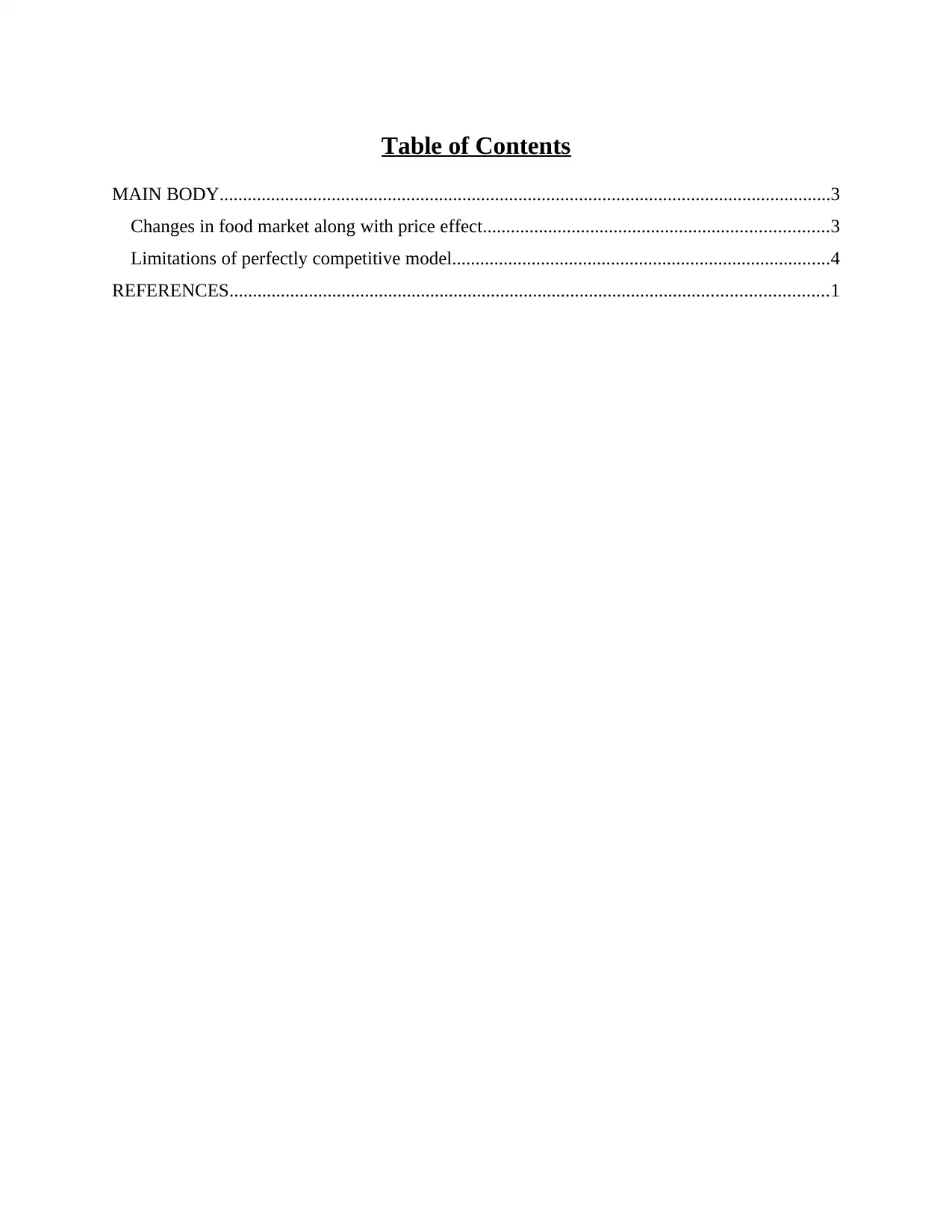
Table of Contents
MAIN BODY...................................................................................................................................3
Changes in food market along with price effect..........................................................................3
Limitations of perfectly competitive model.................................................................................4
REFERENCES................................................................................................................................1
MAIN BODY...................................................................................................................................3
Changes in food market along with price effect..........................................................................3
Limitations of perfectly competitive model.................................................................................4
REFERENCES................................................................................................................................1
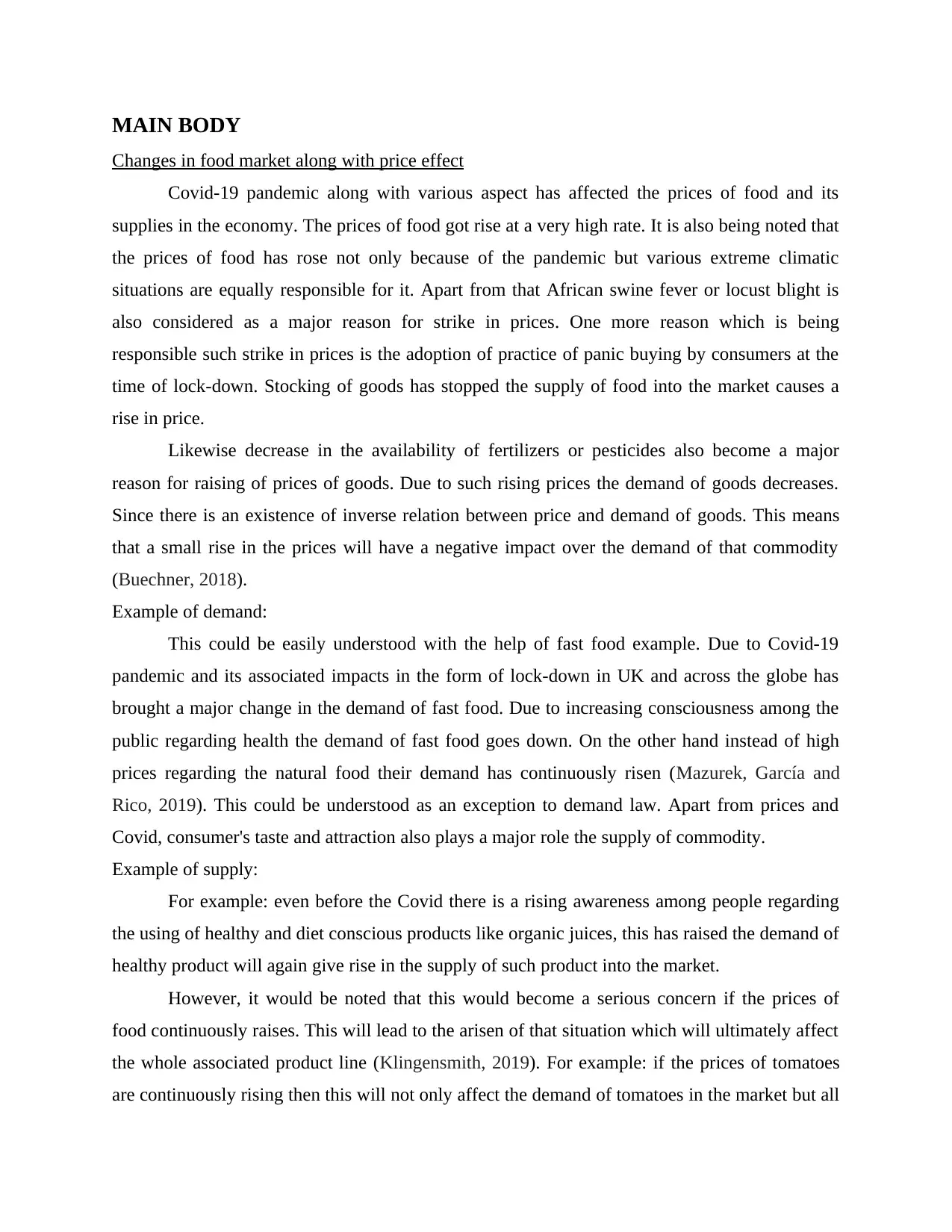
MAIN BODY
Changes in food market along with price effect
Covid-19 pandemic along with various aspect has affected the prices of food and its
supplies in the economy. The prices of food got rise at a very high rate. It is also being noted that
the prices of food has rose not only because of the pandemic but various extreme climatic
situations are equally responsible for it. Apart from that African swine fever or locust blight is
also considered as a major reason for strike in prices. One more reason which is being
responsible such strike in prices is the adoption of practice of panic buying by consumers at the
time of lock-down. Stocking of goods has stopped the supply of food into the market causes a
rise in price.
Likewise decrease in the availability of fertilizers or pesticides also become a major
reason for raising of prices of goods. Due to such rising prices the demand of goods decreases.
Since there is an existence of inverse relation between price and demand of goods. This means
that a small rise in the prices will have a negative impact over the demand of that commodity
(Buechner, 2018).
Example of demand:
This could be easily understood with the help of fast food example. Due to Covid-19
pandemic and its associated impacts in the form of lock-down in UK and across the globe has
brought a major change in the demand of fast food. Due to increasing consciousness among the
public regarding health the demand of fast food goes down. On the other hand instead of high
prices regarding the natural food their demand has continuously risen (Mazurek, García and
Rico, 2019). This could be understood as an exception to demand law. Apart from prices and
Covid, consumer's taste and attraction also plays a major role the supply of commodity.
Example of supply:
For example: even before the Covid there is a rising awareness among people regarding
the using of healthy and diet conscious products like organic juices, this has raised the demand of
healthy product will again give rise in the supply of such product into the market.
However, it would be noted that this would become a serious concern if the prices of
food continuously raises. This will lead to the arisen of that situation which will ultimately affect
the whole associated product line (Klingensmith, 2019). For example: if the prices of tomatoes
are continuously rising then this will not only affect the demand of tomatoes in the market but all
Changes in food market along with price effect
Covid-19 pandemic along with various aspect has affected the prices of food and its
supplies in the economy. The prices of food got rise at a very high rate. It is also being noted that
the prices of food has rose not only because of the pandemic but various extreme climatic
situations are equally responsible for it. Apart from that African swine fever or locust blight is
also considered as a major reason for strike in prices. One more reason which is being
responsible such strike in prices is the adoption of practice of panic buying by consumers at the
time of lock-down. Stocking of goods has stopped the supply of food into the market causes a
rise in price.
Likewise decrease in the availability of fertilizers or pesticides also become a major
reason for raising of prices of goods. Due to such rising prices the demand of goods decreases.
Since there is an existence of inverse relation between price and demand of goods. This means
that a small rise in the prices will have a negative impact over the demand of that commodity
(Buechner, 2018).
Example of demand:
This could be easily understood with the help of fast food example. Due to Covid-19
pandemic and its associated impacts in the form of lock-down in UK and across the globe has
brought a major change in the demand of fast food. Due to increasing consciousness among the
public regarding health the demand of fast food goes down. On the other hand instead of high
prices regarding the natural food their demand has continuously risen (Mazurek, García and
Rico, 2019). This could be understood as an exception to demand law. Apart from prices and
Covid, consumer's taste and attraction also plays a major role the supply of commodity.
Example of supply:
For example: even before the Covid there is a rising awareness among people regarding
the using of healthy and diet conscious products like organic juices, this has raised the demand of
healthy product will again give rise in the supply of such product into the market.
However, it would be noted that this would become a serious concern if the prices of
food continuously raises. This will lead to the arisen of that situation which will ultimately affect
the whole associated product line (Klingensmith, 2019). For example: if the prices of tomatoes
are continuously rising then this will not only affect the demand of tomatoes in the market but all
⊘ This is a preview!⊘
Do you want full access?
Subscribe today to unlock all pages.

Trusted by 1+ million students worldwide
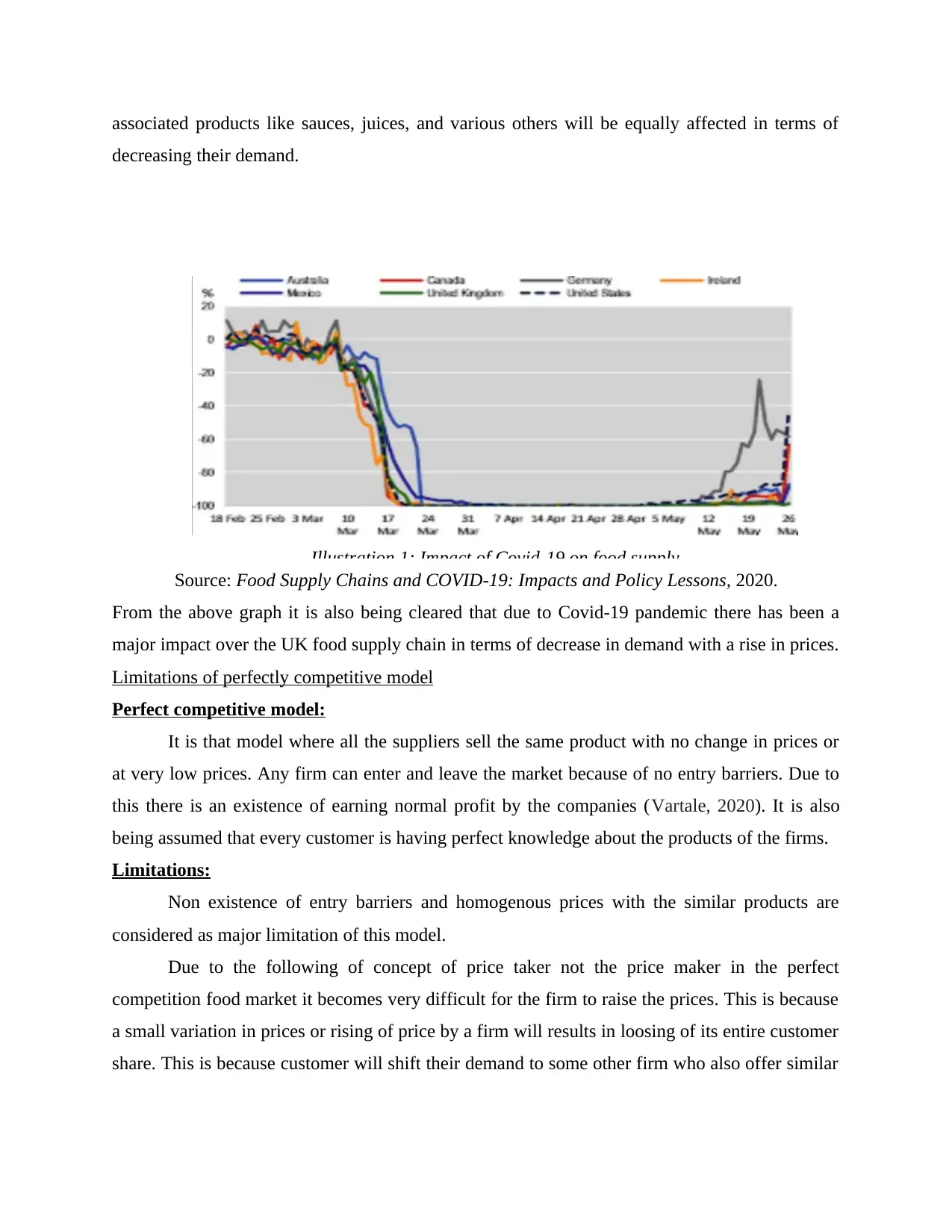
associated products like sauces, juices, and various others will be equally affected in terms of
decreasing their demand.
Source: Food Supply Chains and COVID-19: Impacts and Policy Lessons, 2020.
From the above graph it is also being cleared that due to Covid-19 pandemic there has been a
major impact over the UK food supply chain in terms of decrease in demand with a rise in prices.
Limitations of perfectly competitive model
Perfect competitive model:
It is that model where all the suppliers sell the same product with no change in prices or
at very low prices. Any firm can enter and leave the market because of no entry barriers. Due to
this there is an existence of earning normal profit by the companies (Vartale, 2020). It is also
being assumed that every customer is having perfect knowledge about the products of the firms.
Limitations:
Non existence of entry barriers and homogenous prices with the similar products are
considered as major limitation of this model.
Due to the following of concept of price taker not the price maker in the perfect
competition food market it becomes very difficult for the firm to raise the prices. This is because
a small variation in prices or rising of price by a firm will results in loosing of its entire customer
share. This is because customer will shift their demand to some other firm who also offer similar
Illustration 1: Impact of Covid-19 on food supply
decreasing their demand.
Source: Food Supply Chains and COVID-19: Impacts and Policy Lessons, 2020.
From the above graph it is also being cleared that due to Covid-19 pandemic there has been a
major impact over the UK food supply chain in terms of decrease in demand with a rise in prices.
Limitations of perfectly competitive model
Perfect competitive model:
It is that model where all the suppliers sell the same product with no change in prices or
at very low prices. Any firm can enter and leave the market because of no entry barriers. Due to
this there is an existence of earning normal profit by the companies (Vartale, 2020). It is also
being assumed that every customer is having perfect knowledge about the products of the firms.
Limitations:
Non existence of entry barriers and homogenous prices with the similar products are
considered as major limitation of this model.
Due to the following of concept of price taker not the price maker in the perfect
competition food market it becomes very difficult for the firm to raise the prices. This is because
a small variation in prices or rising of price by a firm will results in loosing of its entire customer
share. This is because customer will shift their demand to some other firm who also offer similar
Illustration 1: Impact of Covid-19 on food supply
Paraphrase This Document
Need a fresh take? Get an instant paraphrase of this document with our AI Paraphraser
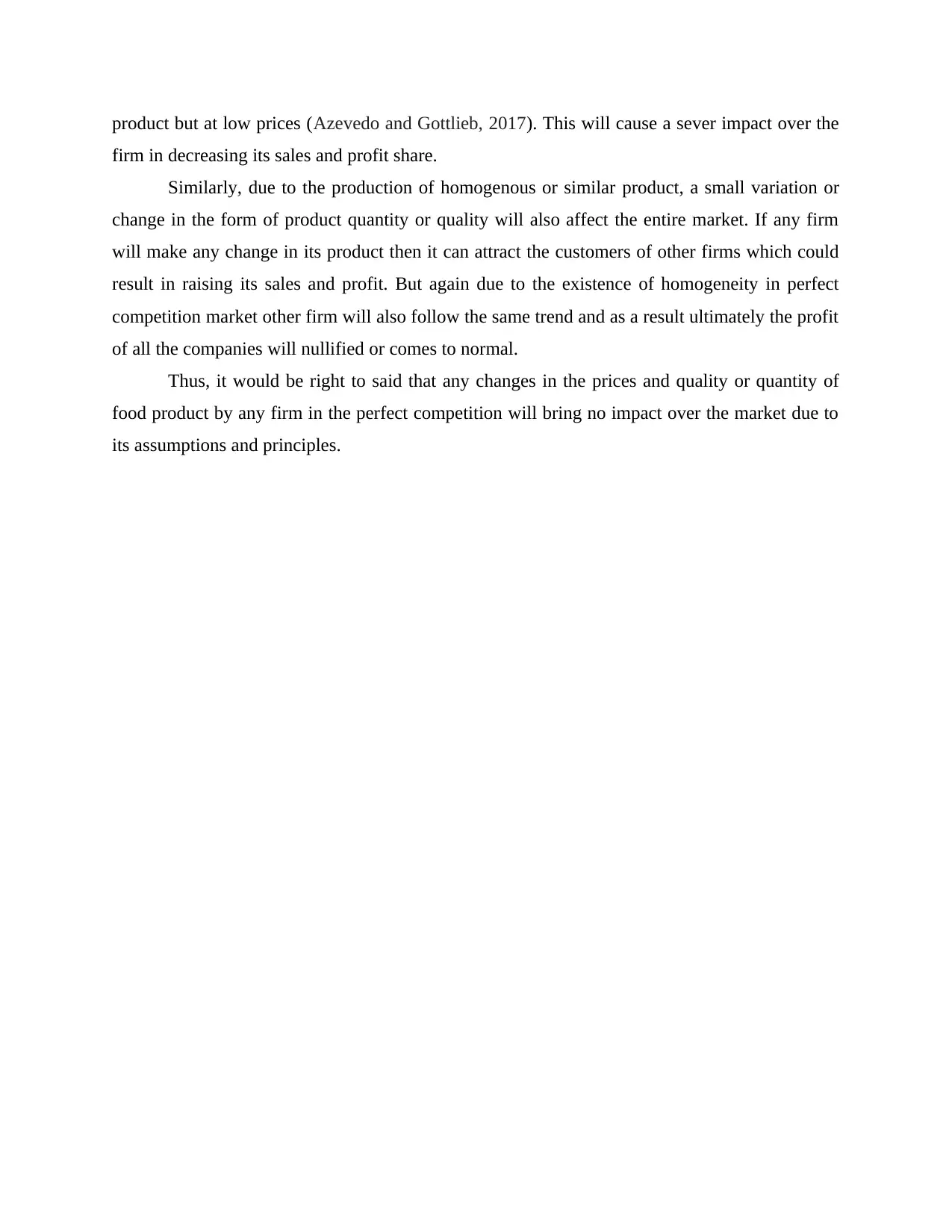
product but at low prices (Azevedo and Gottlieb, 2017). This will cause a sever impact over the
firm in decreasing its sales and profit share.
Similarly, due to the production of homogenous or similar product, a small variation or
change in the form of product quantity or quality will also affect the entire market. If any firm
will make any change in its product then it can attract the customers of other firms which could
result in raising its sales and profit. But again due to the existence of homogeneity in perfect
competition market other firm will also follow the same trend and as a result ultimately the profit
of all the companies will nullified or comes to normal.
Thus, it would be right to said that any changes in the prices and quality or quantity of
food product by any firm in the perfect competition will bring no impact over the market due to
its assumptions and principles.
firm in decreasing its sales and profit share.
Similarly, due to the production of homogenous or similar product, a small variation or
change in the form of product quantity or quality will also affect the entire market. If any firm
will make any change in its product then it can attract the customers of other firms which could
result in raising its sales and profit. But again due to the existence of homogeneity in perfect
competition market other firm will also follow the same trend and as a result ultimately the profit
of all the companies will nullified or comes to normal.
Thus, it would be right to said that any changes in the prices and quality or quantity of
food product by any firm in the perfect competition will bring no impact over the market due to
its assumptions and principles.
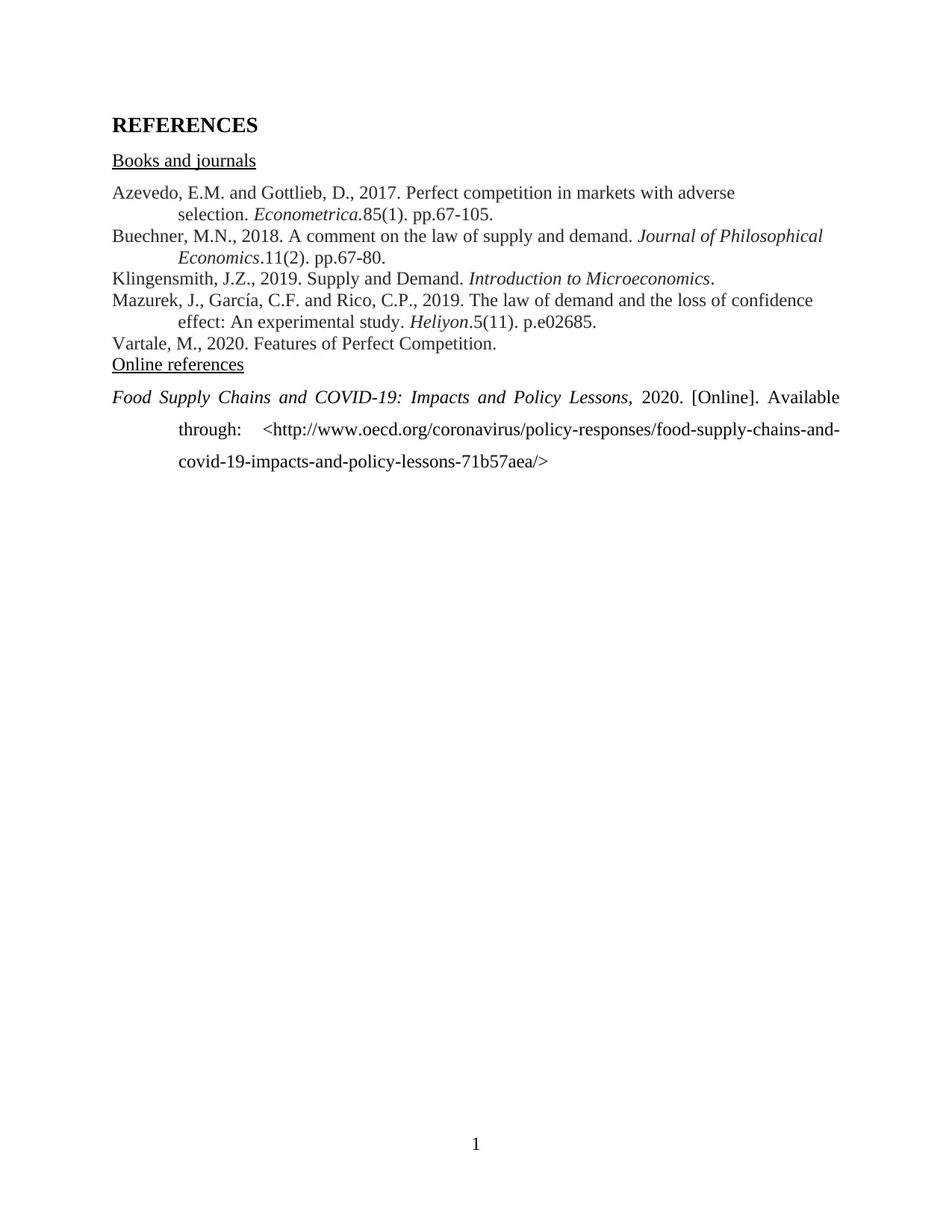
REFERENCES
Books and journals
Azevedo, E.M. and Gottlieb, D., 2017. Perfect competition in markets with adverse
selection. Econometrica.85(1). pp.67-105.
Buechner, M.N., 2018. A comment on the law of supply and demand. Journal of Philosophical
Economics.11(2). pp.67-80.
Klingensmith, J.Z., 2019. Supply and Demand. Introduction to Microeconomics.
Mazurek, J., García, C.F. and Rico, C.P., 2019. The law of demand and the loss of confidence
effect: An experimental study. Heliyon.5(11). p.e02685.
Vartale, M., 2020. Features of Perfect Competition.
Online references
Food Supply Chains and COVID-19: Impacts and Policy Lessons, 2020. [Online]. Available
through: <http://www.oecd.org/coronavirus/policy-responses/food-supply-chains-and-
covid-19-impacts-and-policy-lessons-71b57aea/>
1
Books and journals
Azevedo, E.M. and Gottlieb, D., 2017. Perfect competition in markets with adverse
selection. Econometrica.85(1). pp.67-105.
Buechner, M.N., 2018. A comment on the law of supply and demand. Journal of Philosophical
Economics.11(2). pp.67-80.
Klingensmith, J.Z., 2019. Supply and Demand. Introduction to Microeconomics.
Mazurek, J., García, C.F. and Rico, C.P., 2019. The law of demand and the loss of confidence
effect: An experimental study. Heliyon.5(11). p.e02685.
Vartale, M., 2020. Features of Perfect Competition.
Online references
Food Supply Chains and COVID-19: Impacts and Policy Lessons, 2020. [Online]. Available
through: <http://www.oecd.org/coronavirus/policy-responses/food-supply-chains-and-
covid-19-impacts-and-policy-lessons-71b57aea/>
1
⊘ This is a preview!⊘
Do you want full access?
Subscribe today to unlock all pages.

Trusted by 1+ million students worldwide
1 out of 6
Related Documents
Your All-in-One AI-Powered Toolkit for Academic Success.
+13062052269
info@desklib.com
Available 24*7 on WhatsApp / Email
![[object Object]](/_next/static/media/star-bottom.7253800d.svg)
Unlock your academic potential
Copyright © 2020–2025 A2Z Services. All Rights Reserved. Developed and managed by ZUCOL.





